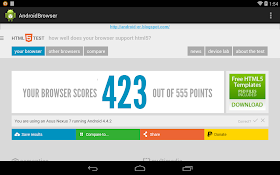This example show user-agent of your WebView, and also include a link to HTML5TEST to test your HTML compatibility. It's how it run on Nexus 7 running Android 4.4.2 KitKat, and on HTC One X running 4.2.2.
Run on Nexus 7, Android 4.4.2
Run on HTC One X, Android 4.2.2
Android 4.4 (KitKat) includes a new WebView component based on the Chromium open source project. The new WebView includes an updated version of the V8 JavaScript engine and support for modern web standards that were missing in the old WebView. It also shares the same rendering engine as Chrome for Android, so rendering should be much more consistent between the WebView and Chrome.
The new WebView adds Chrome/_version_ to the user-agent string.
~ about WebView for Android
/assets/mypage.html
<!DOCTYPE html>
<html>
<head>
<meta charset="UTF-8">
<meta name="viewport" content="width=device-width; user-scalable=0;" />
<title>My HTML</title>
</head>
<body>
<h1>MyHTML</h1>
<p id="mytext">Hello!</p>
<p>my User-agent</P>
<p id="myUA">Hello!</p>
<br/>
visit: <a href="http://html5test.com/">http://html5test.com/</a>
<script language="javascript">
document.getElementById("myUA").innerHTML=navigator.userAgent;
</script>
</body>
</html>
MainActivity.java
package com.example.androidbrowser;
import android.support.v7.app.ActionBarActivity;
import android.support.v4.app.Fragment;
import android.os.Bundle;
import android.view.LayoutInflater;
import android.view.Menu;
import android.view.MenuItem;
import android.view.View;
import android.view.ViewGroup;
import android.webkit.WebView;
import android.webkit.WebViewClient;
public class MainActivity extends ActionBarActivity {
@Override
protected void onCreate(Bundle savedInstanceState) {
super.onCreate(savedInstanceState);
setContentView(R.layout.activity_main);
if (savedInstanceState == null) {
getSupportFragmentManager().beginTransaction()
.add(R.id.container, new PlaceholderFragment()).commit();
}
}
@Override
public boolean onCreateOptionsMenu(Menu menu) {
// Inflate the menu; this adds items to the action bar if it is present.
getMenuInflater().inflate(R.menu.main, menu);
return true;
}
@Override
public boolean onOptionsItemSelected(MenuItem item) {
// Handle action bar item clicks here. The action bar will
// automatically handle clicks on the Home/Up button, so long
// as you specify a parent activity in AndroidManifest.xml.
int id = item.getItemId();
if (id == R.id.action_settings) {
return true;
}
return super.onOptionsItemSelected(item);
}
/**
* A placeholder fragment containing a simple view.
*/
public static class PlaceholderFragment extends Fragment {
WebView myBrowser;
public PlaceholderFragment() {
}
@Override
public View onCreateView(LayoutInflater inflater, ViewGroup container,
Bundle savedInstanceState) {
View rootView = inflater.inflate(R.layout.fragment_main, container,
false);
myBrowser = (WebView) rootView.findViewById(R.id.mybrowser);
myBrowser.getSettings().setJavaScriptEnabled(true);
myBrowser.loadUrl("file:///android_asset/mypage.html");
//open new web page in the same myBrowser webview
myBrowser.setWebViewClient(new WebViewClient() {
@Override
public boolean shouldOverrideUrlLoading(WebView view, String url) {
view.loadUrl(url);
return false;
}
});
return rootView;
}
}
}
/res/layout/fragment_main.xml
<?xml version="1.0" encoding="utf-8"?>
<LinearLayout xmlns:android="http://schemas.android.com/apk/res/android"
android:layout_width="fill_parent"
android:layout_height="fill_parent"
android:orientation="vertical" >
<TextView
android:layout_width="wrap_content"
android:layout_height="wrap_content"
android:layout_gravity="center_horizontal"
android:autoLink="web"
android:text="http://android-er.blogspot.com/"
android:textStyle="bold" />
<WebView
android:id="@+id/mybrowser"
android:layout_width="fill_parent"
android:layout_height="fill_parent" />
</LinearLayout>
/res/layout/activity_main.xml, default generated without changed.
<FrameLayout xmlns:android="http://schemas.android.com/apk/res/android"
xmlns:tools="http://schemas.android.com/tools"
android:id="@+id/container"
android:layout_width="match_parent"
android:layout_height="match_parent"
tools:context="com.example.androidbrowser.MainActivity"
tools:ignore="MergeRootFrame" />
In order to visit Internet, permission of "android.permission.INTERNET" is needed in AndroidManifest.xml.
<?xml version="1.0" encoding="utf-8"?>
<manifest xmlns:android="http://schemas.android.com/apk/res/android"
package="com.example.androidbrowser"
android:versionCode="1"
android:versionName="1.0" >
<uses-sdk
android:minSdkVersion="8"
android:targetSdkVersion="19" />
<uses-permission android:name="android.permission.INTERNET"/>
<application
android:allowBackup="true"
android:icon="@drawable/ic_launcher"
android:label="@string/app_name"
android:theme="@style/AppTheme" >
<activity
android:name="com.example.androidbrowser.MainActivity"
android:label="@string/app_name" >
<intent-filter>
<action android:name="android.intent.action.MAIN" />
<category android:name="android.intent.category.LAUNCHER" />
</intent-filter>
</activity>
</application>
</manifest>
Running on Nexus 7, Android 4.4 Kitkat.




You can simplier:
ReplyDeleteTextView textView = (TextView)findViewById(R.id.textView);
WebView webView = (WebView)findViewById(R.id.webView);
WebSettings webSettings = webView.getSettings();
textView.setText(webSettings.getUserAgentString());